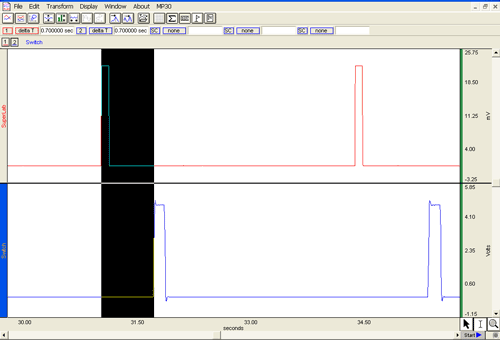H30 Stroop Effect

This PRO Lesson explains how to run a classic Stroop test using SuperLab to deliver the stimuli.
If the word “red” is printed in blue ink how will the interference of the ink-color “blue” upon reading the printed word “red” compare with the interference of the printed word “red” upon calling the name of the ink-color “blue?” The increase in time for reacting to words caused by the presence of conflicting color stimuli is taken as the measure of the interference of color stimuli upon reading words. The increase in the time for reacting to colors caused by the presence of conflicting word stimuli is taken as the measure of the interference of word stimuli upon naming colors. (p. 646-647)
—Stroop, J.R. (1935). Studies of interference in serial verbal reactions. Journal of Experimental Psychology, 18, 643-662.
Experimental Objectives
- To measure and compare strength of interference between two associative tasks: naming and reading.
- To measure and compare reaction time for the effect of word and visual interference.
- To measure, compare, and correlate the interference of color stimuli upon reading words.
- To measure, compare, and correlate the interference of word stimuli upon naming colors.
Tasks Performed by the Student
-
Sit and relax in front of the computer monitor displaying SuperLab.
-
Segments 1 (RCNb) and 2 (RCNd): Read the screen aloud and press the hand switch at the same time.
-
Segments 3 (NC) and 4 (NCWd): Name the color aloud and press the hand switch at the same time.
Videos
Biopac Student Lab Student Download
Student Prep & Distance Learning
Click the link(s) below for sample data and/or lesson procedure video(s), BSL PRO Lesson procedures (PDF) for human lessons*, and graph template files (*.gtl) for BSL PRO Lessons. If more than one .gtl is available, download the .gtl with the _suffix to match BSL version and hardware.
Lesson Hardware
This lesson requires a Biopac Student Lab (BSL) System and the following hardware. If your BSL System does not include all hardware items, expand your system by selecting required items below. For more details, review the Lesson: L# BSL Lessons - see the Lab Manual or launch BSL; A# and H# BSL PRO Lessons, click the PDF link above to review full setup, recording, and analysis procedures.
| Item | Name | Cart |
|---|---|---|
| STP35W | SuperLab System for MP36/35 or MP36R | Add to Cart |
| SS10L | Push Button Hand Switch - MP3X/45 | Add to Cart |
Stay Connected